Art has long been a medium for exploring the depths of human emotion, from joy and beauty to sorrow and fear. While much of art celebrates the sublime and the serene, there exists a darker side to creativity – a realm where terror reigns supreme.
Join us as we embark on a chilling journey through the depths of art history to uncover some of the most terrifying artworks ever created. Each one is a haunting testament to the varying depths of human imagination and fear.
The Persistence of Memory by Salvador Dalí
Salvador Dalí’s “The Persistence of Memory” is perhaps one of the most iconic and unsettling works of Surrealist art ever created. Painted in 1931, this enigmatic masterpiece features a barren landscape populated by surreal, melting clocks draped over various objects that are nearly indistinguishable in their form.
Dalí’s image is reminiscent of a hallucinogenic experience and encapsulates the horror of a bad trip. The metal clocks are melting across the image, including over a distorted human face.
Ants, which are a common representation of decay in Dalí’s works, are gathering to consume the golden watch. The entire image seems to be slipping away, decomposing in front of the viewer’s eyes.
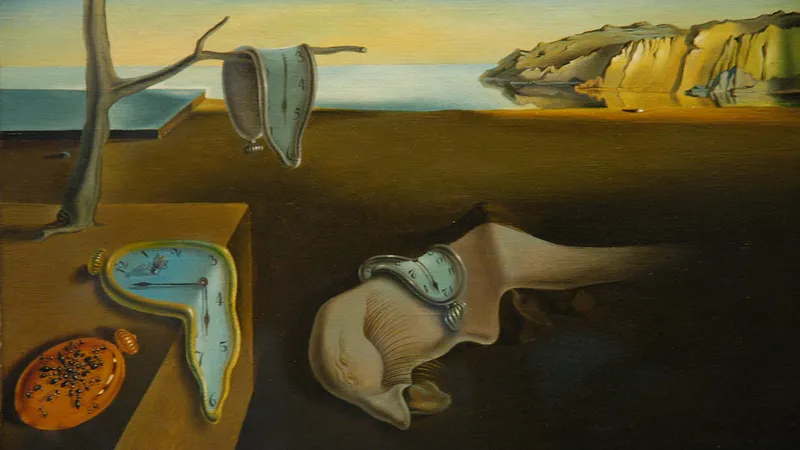
The dreamlike quality of the scene, coupled with its eerie imagery, evokes a sense of disorientation and unease. The symbolism of the clocks melting invokes a message of time slipping away, perhaps referencing the abject horror of degenerative mental diseases.
Alternatively, Dalí may be commenting on the ineffable nature of memory in general and the ease with which they slip away. The horror of this work is innate to the human experience rather than an external factor and reminds the viewer of their fleeting mortality.
Saturn Devouring His Son by Francisco Goya
Francisco Goya’s “Saturn Devouring His Son” is a chilling portrayal of the ancient Greek myth of the Titan Cronus (or the Roman equivalent Saturn). It is housed in the Museo del Prado in Madrid, Spain.
Cronus, the god of agriculture, was informed of a prophecy that one of his sons would overthrow him. As a result, he decided to devour his offspring to prevent the prophecy from coming true.
“Saturn Devouring His Son” depicts this point of the tale, as Cronus is consuming his children. Painted between 1819 and 1823 as part of Goya’s “Black Paintings” series, this image is one of 14 painted at the end of his career. It reflects a fear of insanity and an overall loss of faith in humanity.
The stylistic choices Goya makes in depicting Saturn emphasize a grotesque and realistic portrayal of cannibalism. It highlights the gore and visceral intensity of such an act, despite the myth typically being that he ate the children whole.
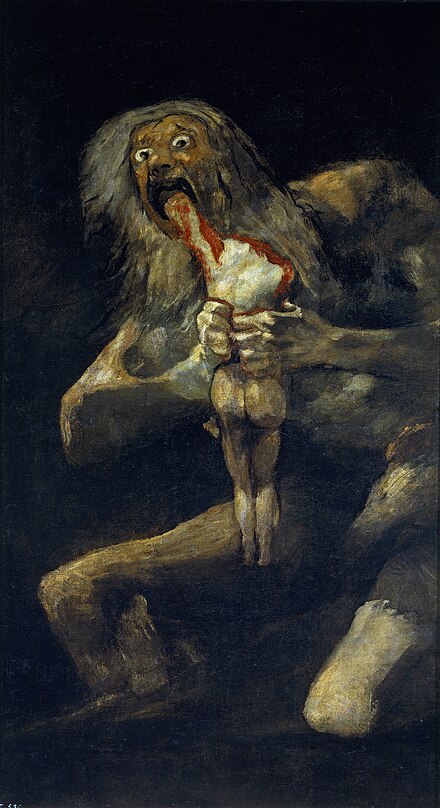
While not necessarily fear-inducing, the image does encourage one to recoil away in disgust and horror. It was displayed in Goya’s home alongside the other Black Paintings.
They all utilize darkness as a major theme. They reflect Goya’s deteriorating mind at the end of his life as he feared slipping away from the sanity he had always known.
Scholars still debate the themes Goya explicitly meant to highlight, including theories of the wrath of God, conflicts between the young and the old, and reflections on his own war-torn country.
Whatever the real meaning, it is clear to any viewer the madness in Saturn’s eyes as he devours the lifeless body of his child, and the fear that Goya must have felt and attempted to imbue in any onlooker.
The Garden of Earthly Delights by Hieronymus Bosch
Hieronymus Bosch’s “The Garden of Earthly Delights” is a triptych painting that offers a surreal and macabre vision of sin, temptation, and damnation. Created in the early 16th century, this sprawling work depicts a surreal landscape across a triad of panels, representing three distinct scenes.
On the outside of the triptych, to lay the groundwork for the inner images, Bosch depicts the creation of the world. Opening the triptych leads to the strange world Bosch interpreted.
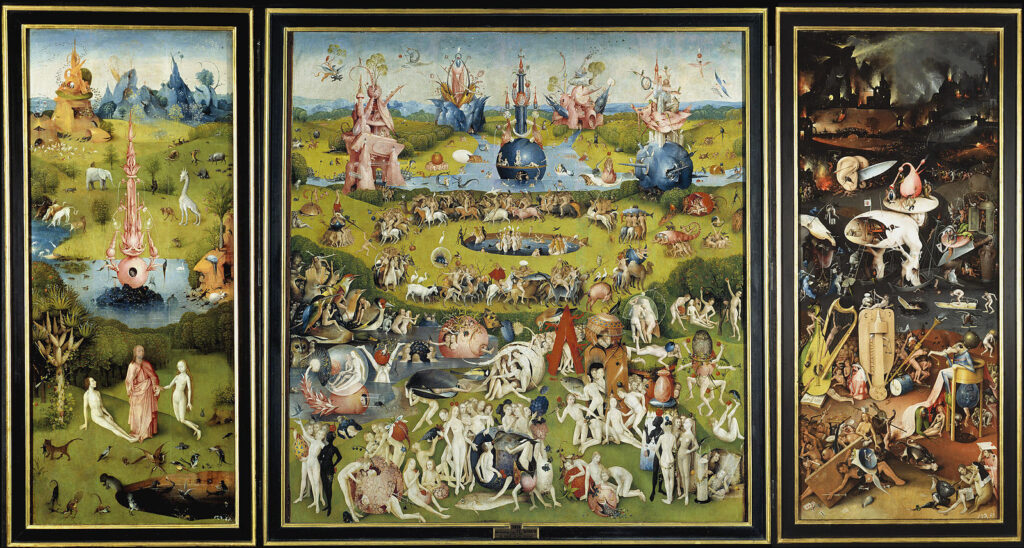
The left panel is God creating Adam and Eve in the Garden of Eden, surrounded by beautiful natural scenery and wildlife. In the second panel, the beautiful grassy background remains but the world is no longer a pristine paradise.
Instead, it is teeming with bizarre creatures interacting with humans in a strange fantasy world. Fish walk on land, creatures like mermaids interact with humans committing debaucherous acts, and strange architecture dots the landscape.
It is a far cry from the paradise of the left panel. It is implied to be the gateway to the final panel: a glimpse at damnation.
As strangely different as panel two is from panel one, panel three is equally as demented. Grotesque creatures engage in acts of debauchery, torture, and damnation, while figures like a pair of ears wielding a knife dot the landscape.
From the surreal Garden of Eden to the fiery pits of hell, Bosch’s nightmarish imagery transports viewers to a world of sin and suffering.
Guernica by Pablo Picasso
Pablo Picasso’s “Guernica” is a powerful anti-war painting that depicts the horrors of the Spanish Civil War. This work was painted in 1937 in response to the bombing of the Basque town of Guernica by German and Italian forces.
Spanish Republicans called on the fascist forces abroad to bomb Guernica as a message to the rebels. They obliged, leveling the city.
As a result, the citizens of the city suffered the realities of a war they did not ask for. This work of art is a broad condemnation and visceral depiction of the suffering, chaos, and destruction warfare causes.
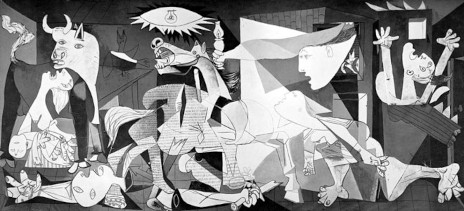
As with much cubist art, the message of the artwork is muddled at first glance. However, upon reflection, it becomes clear that Guernica depicts multiple people and animals in intense agony.
Rendered in stark black, white, and gray tones, Picasso presents a heart-wrenching image of the suffering of Guernica. The painting features distorted figures, anguished faces, and writhing bodies, all engulfed in flames and agony which captures the horrible reality faced by humans and nature alike.
“Guernica” serves as a chilling reminder of the atrocities of war and the human capacity for violence and cruelty. While not as terrifying as other works of art that induce a deep fear or tap into the human psyche, “Guernica” does incite a deep emotional connection.
It confronts the viewer with the realities of war and the pain and suffering it can cause.
The Scream by Edvard Munch
Edvard Munch’s “The Scream” is perhaps one of the most iconic and universally recognized images of terror ever created. Painted in 1893, this haunting masterpiece depicts a figure standing on a bridge.
Their face is contorted in a silent scream of anguish and despair. Munch claims that he gained inspiration when he was out for a walk one night.
He encountered the right sunset sky and felt an intense scream echoing throughout nature. He intended to capture the sense of terror he encountered that night with “The Scream.”
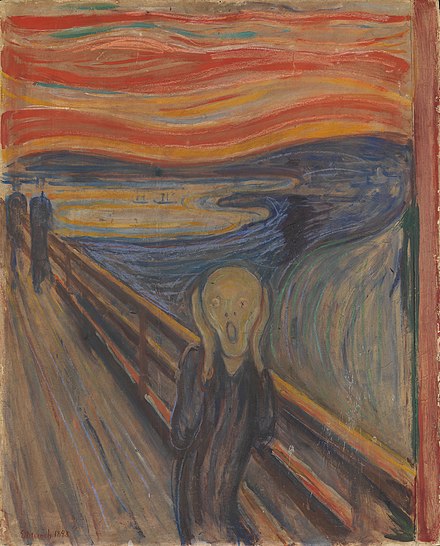
The swirling colors are reminiscent of the sunset sky Munch describes as his motivation. The distorted forms of the landscape add to the sense of disorientation and existential dread.
The ambiguous person screaming, with their hands on their face, captures the overwhelming terror of the human condition. The figure is purposefully sexless and mostly featureless, a stand-in for the viewer to cast their own fear onto.
“The Scream” is a modern masterpiece, recognized across the globe by nearly everyone, and encapsulates the reality of modern-day anxieties and terror.
The Smiling Spider by Odilon Redon
Odilon Redon’s “The Smiling Spider” is a haunting and enigmatic work that encapsulates the essence of symbolism in art. Created in the late 19th century, Redon’s piece is a testament to his mastery of evoking mystery and his adoration of the color black.
Created as part of his “noirs” collection, Redon explored in depth the variety of art he could create with charcoal, fleshing out the large, looming spider. At first glance, the painting of the spider presents a seemingly innocent subject: a spider with a serene smile adorning its face.
However, upon deeper contemplation, viewers are drawn into a world of ambiguity and psychological depth.
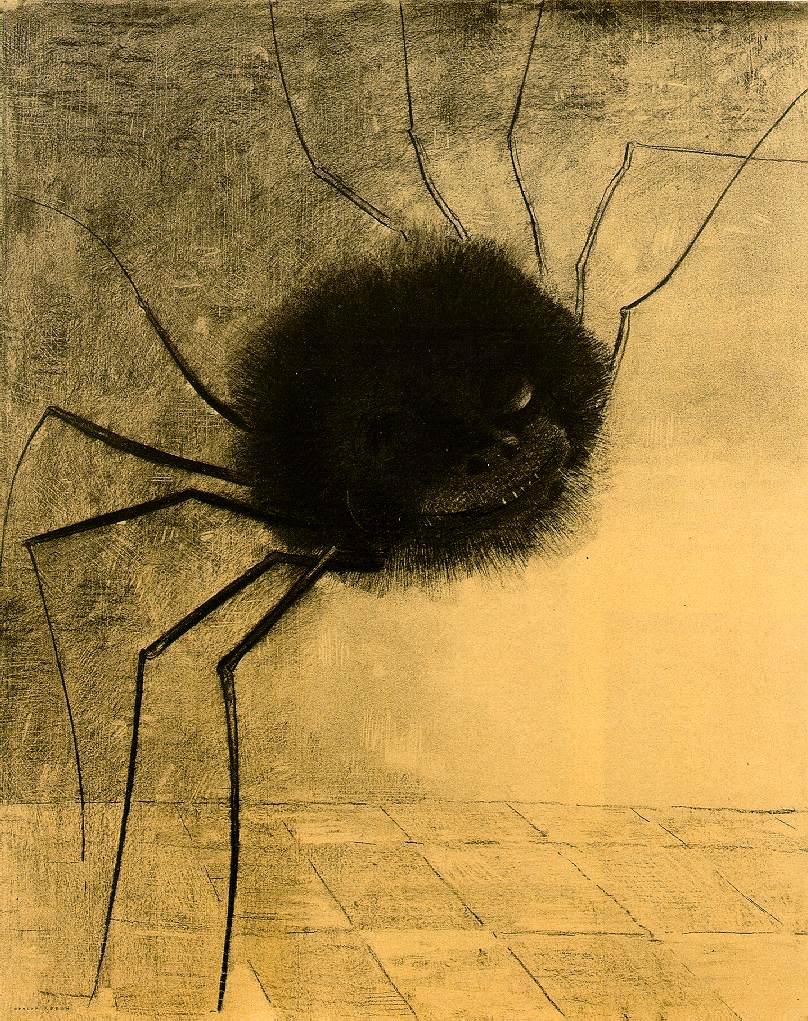
The spider, traditionally associated with fear and danger, is transformed in Redon’s hands into a symbol of enigmatic beauty. Its smile challenges conventional perceptions, inviting viewers to question their preconceived notions about the terrifying creatures.
Redon’s use of color and texture adds to the painting’s allure, with subtle shifts in light and shadow creating an atmosphere of both fascination and unease. Despite his best attempts, many still find the image more creepy than adorable, with the human smile only adding to the distaste of the creature.
“The Smiling Spider” is a prime example of Redon’s fascination with the mysterious and the subconscious. Through his exploration of symbolism, he invites viewers to confront their fears and embrace the unknown.
The painting’s enduring appeal lies in its ability to elicit a range of emotions and interpretations. This makes it a timeless masterpiece that continues to captivate audiences to this day.
The Triumph of Death by Pieter Bruegel the Elder
Pieter Bruegel the Elder’s “The Triumph of Death” is a chilling and thought-provoking masterpiece. It portrays the inevitability of mortality and the horrors of human suffering.
Painted in the 16th century during a period of social upheaval and religious turmoil in Europe, Bruegel’s work serves as a powerful commentary on the fragility of life and the indiscriminate nature of death.
The painting depicts a vast landscape overrun by death and destruction. Skeletons and corpses litter the scene, symbolizing the relentless march of mortality that spares no one, regardless of status or wealth.
In the foreground, figures from all walks of life – nobles, peasants, clergy – are depicted in various states of despair and agony as they succumb to death’s embrace.
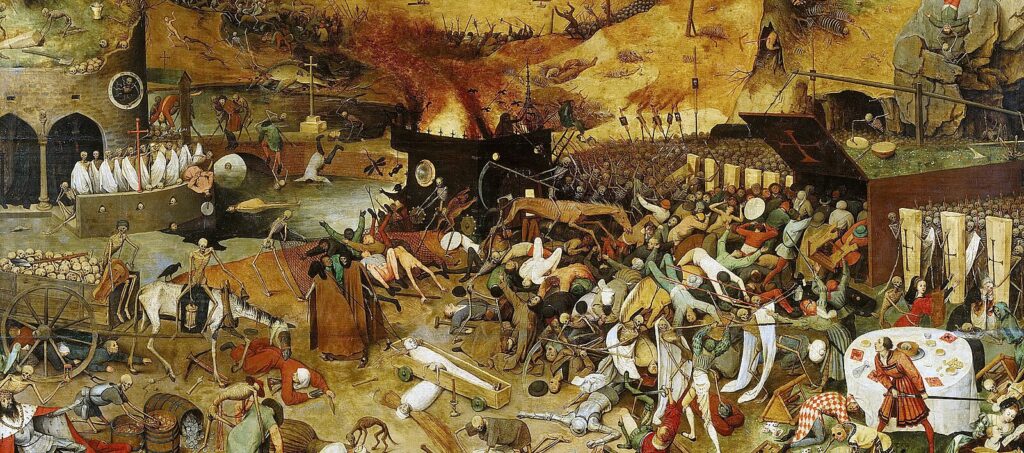
Bruegel’s meticulous attention to detail and his ability to capture the chaos and despair of the moment are evident throughout the painting. The skeletons serve as broad symbolism of death.
They depict how famine, the church, and the military are all causes of death. They are an overwhelming force, attacking the humans from all sides in unrelenting waves, with different motivations across the painting.
From the macabre dance of skeletons to the burning villages in the background, every element serves to heighten the sense of dread and inevitability.
“The Triumph of Death” is a powerful reminder of the transient nature of life and the futility of human endeavors in the face of mortality. It challenges viewers to contemplate their own mortality and to reflect on the true value of existence in the face of such overwhelming destruction.
Conclusion
From Salvador Dalí’s surreal landscapes to Pablo Picasso’s harrowing depictions of violence and madness, the world of art has no shortage of terror-inducing images.
These artworks serve as powerful reminders of the darker aspects of the human experience. They invite viewers to confront their deepest fears and anxieties.
Whether through surrealism, symbolism, or stark realism, the most terrifying art ever created holds a mirror to the darkest recesses of the human psyche. It challenges us to confront the shadows that lurk within us all.
As we gaze upon these chilling masterpieces, we are reminded of the enduring power of art to evoke emotions by appealing to both natural and supernatural concepts.
References
“Hieronymus Bosch’s ‘The Garden of Earthly Delights’, A Journey from Heaven to Hell and Back.” Sotheby’s, August 10, 2023. https://www.sothebys.com/en/videos/hieronymus-bosch-the-garden-of-earthly-delights.
Leal, Paloma Esteban.“Guernica.” Museo Reina Sofia. https://www.museoreinasofia.es/en/collection/artwork/guernica.
“Salvador Dalí: The Persistence of Memory.” MoMa, 2024. https://www.moma.org/collection/works/79018.
“The Scream, 1893 by Edvard Munch.” Edvardmunch.org. https://www.edvardmunch.org/the-scream.jsp.
“The Triumph of Death.”Museo del Prado. https://www.museodelprado.es/en/the-collection/art-work/the-triumph-of-death/d3d82b0b-9bf2-4082-ab04-66ed53196ccc.
“What is “Saturn Devouring His Own Son”? An explanation of Goya’s masterpiece!” TRiCERA Art, 2/17/2023. https://www.tricera.net/artclip/blog805.